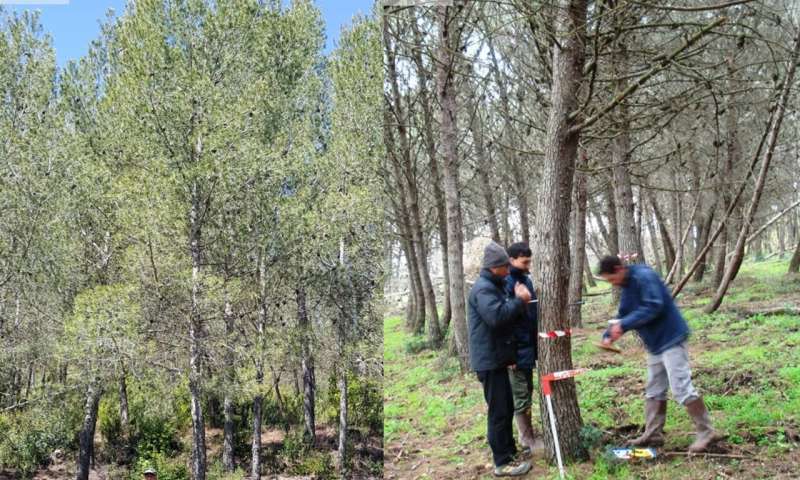Aleppo pine population responses to climate change reveal differential sensitivity to precipitation

Trees are crucial organisms in many terrestrial ecosystems. Tree responses to climate variations could influence the global carbon and water cycles considerably and affect the ecosystem services that forests provide. However, the way ecologically important species from dry areas respond to the challenges of climate change has been insufficiently studied. We argue that tree species from dry areas require further research to implement the required mitigation policies for their conservation.
In our work, we examined the relative importance of climate factors related to height growth patterns among populations of the Aleppo pine, a widely distributed conifer across the Mediterranean basin.
What is the role of climate on tree growth?
The performance of trees is closely linked to climate factors (e.g., temperature, precipitation), and these factors vary between the local and regional scale. Consequently, their relevance in explaining tree growth of forests of widely distributed species is potentially high, while tree populations often show patterns of local adaptation related to climate. To improve the accuracy of our estimation of tree height and performance for a thermophilic species under current and future climate, we need to know the relative importance of precipitation and temperature under varying degrees of water shortage. This combination of factors is known to influence the adaptive variation in thermophilic species.
Evaluating the effect of climate on tree growth
In this new study, we quantified the significance of precipitation and temperature for tree growth and aimed to understand whether populations from drier environments are more likely to decline in growth by climate warming than those occupying wetter areas. In order to evaluate the relative importance of temperature and precipitation for tree growth, it is necessary to test changes in the growth of populations from different origins over time under varying local climates. It is possible to do in long-term experiments known as common gardens, which often originate from international trial networks.
We used data from 14 long-term common-garden experiments from the Mediterranean basin, where tree height was measured every one to five years in about 150 populations of the species. Age 15 years was used as an indicator of productivity, and tree growth responses to temperature and precipitation were investigated across experiments. The Aleppo pine populations were categorized into five ecotypes, in other words, climate-based classes of populations, through the combination of three climate characteristics: wet or dry summer, semi-arid or sub-humid conditions, and temperate or cold/cool temperature regimes. The differentiation by climate was strong throughout the species range.

Is temperature or precipitation more significant for tree growth?
We found that all ecotypes had nearly uniform responses to temperature. Interestingly, the climate factor most relevant to explain the ecotypic growth patterns of the pine was annual precipitation, thereby determining adaptive differentiation. Aleppo pine trees are adapted at the local level, particularly the ecotypes originating from sub-humid climates from the northern and eastern Mediterranean, which could be related to the evolutionary history and selection by climate within the species.
What will be the fate of tree growth under climate change?
We projected the growth patterns locally and across the species' range under the future climate of a "moderate" and a pessimistic scenario of carbon emissions for the period 2071-2100 AD. The projected climate responses of range-wide patterns implied either tree height inhibition or stimulation of up to 75% under climate change. In general, extensive height-growth reductions can be expected for coastal areas of France, Greece, Spain and northern Africa. Ecotypes that are currently experiencing more favorable (wetter) climate conditions are those at the highest risk.
Implications of the ecotype performance for conservation strategy of Aleppo pine and other species of dry forests
We found that one of the ecotypes native to the eastern Mediterranean basin exhibits high genetic diversity and encompasses most of the functional variation of the Aleppo pine. Because it has a high degree of plasticity in its response to climate, this ecotype may be decisive for the persistence of species through climate change and could be used for assisted migrations. Our team concludes that between-population variation in sensitivity to precipitation must be considered when projecting tree height responses of dry forests to future climate.
This story is part of Science X Dialog, where researchers can report findings from their published research articles. Visit this page for information about ScienceX Dialog and how to participate.
More information:
Theofania S. Patsiou et al. Intraspecific responses to climate reveal nonintuitive warming impacts on a widespread thermophilic conifer, New Phytologist (2020). DOI: 10.1111/nph.16656
Bio:
Theofania Patsiou is a Post-doctoral researcher at the University of Bern Switzerland working on plant Ecology and Evolutionary Biogeography under past, current, and future climate oscillations.
Jordi Voltas is Professor at the University of Lleida, Spain working on the ecophysiological and adaptive characterisation of forest trees under Mediterranean conditions in the face of global change.